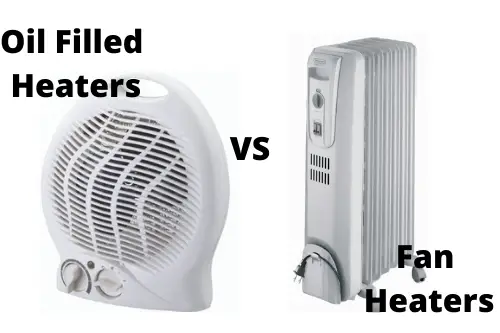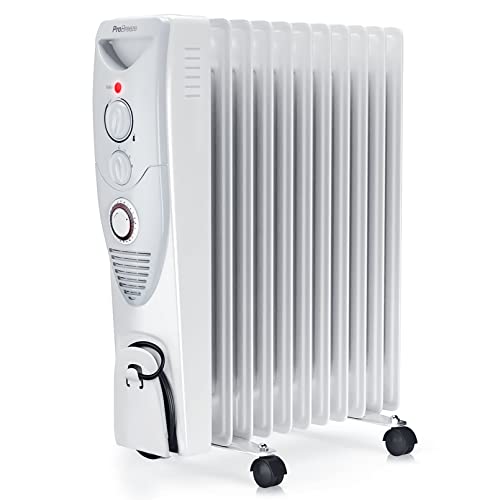With the coming of the winter season, securing or buying a heater will probably be on most people’s mind. Especially if your central heating isn’t quite working out for you, or if you stay in an area without gas heating. In light of that, your first thought for winter shopping would likely be getting a portable heater.

However, with all the options available, most people often face the problem of which heater bests suits their homes, as well as the most difficult problem of which heater is best or which to purchase.
Often times, the problems surrounding which heater best suits your home is based on the features of the said home, such as the size of the room, the space you can allot for the heater, etcetera. There is also the question of which heater is the best and that is the major dilemma most people face.
So, should you opt for oil-filled heaters or fan heaters? Well, making this decision just got easier as we have provided all the information about both that will nudge you in the right direction towards making a choice. Keep reading to learn more.
Oil-Filled Heaters
Oil-filled heaters, which are also referred to as oil-filled radiators or thermal fluid radiators, are one of the most widely used types of heaters today.
Last update on 2024-03-21 / Images from Amazon Product Advertising API
An oil-filled heater basically operates as a convection heater, whereby it provides heat via the general process of radiation and convection.
However, unlike other heaters that utilize this same means, an oil-filled heater makes use of different components to achieve the same process. The components used by an oil-filled heater is first of oil, the thermodynamic oil it is equipped with, combined with electrical elements that form the heater’s base.
You should note that the oil an oil-filled heater uses, which is thermodynamic oil, is not used as fuel for the heater, but as a heat reservoir which combines with the electric components in place to create long-lasting heat.
Therefore, when it comes to how an oil-filled heater works, you should note that it is basically by the electrical elements at the heater’s base heating up the oil, which then by means of convection[1] spreads around the open cavities of the heater to emit heat.
Fan Heaters
As earlier stated, fan heaters are a type of portable electric heaters and the most well known and widely used.
Last update on 2024-03-24 / Images from Amazon Product Advertising API
As you might know, electric heaters are generally made and designed to provide heat for small areas or rooms, and they generally achieve this by making use of the various heating elements they are usually equipped with.
Most of the time, the heating elements electric heaters are designed with are either made of ceramic or metal. Now, when it comes to our main focus which is the fan heater, it basically does the same thing and utilises the same process. In light of that, a fan heater basically works by making use of an electric coil to generate heat and then uses the fans to blow the heat across the room.
Differences Between an Oil-Filled Heater and a Fan Heater
The first major difference between both heaters is in their heating capabilities, in regards to the size of the room or area that needs to be heated. This translates to the fact that electric heaters and most especially fan heaters are not suitable for large rooms or areas, rather they fit and work better in smaller areas or rooms.
This, however, is in contrast to an oil-filled heater which is capable of heating up large areas and rooms, as the convection process it makes use of perfectly allows heat to flow across the room.
The next major difference of note is in how portable the heaters are. When it comes to portability, the fan heater definitely has the Oil-filled heater beat. This is because the fan heater is by far lighter in weight than the oil-filled heat. Especially when you consider the fact that oil-filled heaters make use of oil, which is a heavy liquid. Furthermore, you should note that due to oil being a heavy liquid, as well as other components oil-filled heaters come equipped with, most often weigh above 20lbs.
Finally, the last major difference we’ll highlight here is on heat retention between the two heaters. In that aspect, the oil-filled heater is designed to always come up tops, as it is designed to have amazing heat retention features and as such, can properly maintain the desired temperature for a long time and at low power too.
However, the fan heater doesn’t match up to that standard at all, in fact, fan heaters have a disadvantage of quick heat loss. The reason for the said disadvantage is due to the fact that fan heaters primarily rely on spreading heat through the air, hence, warmth can quickly be lost when you let in a draught or if you have drafty windows.
Pros & Cons of Oil-Filled Heaters and Fan Heaters
A good way to understand the difference between two products, as well as to decide on a choice is to take into consideration the pros and cons of each product. Hence, below are the pros and cons of an oil-filled heater and a fan heater respectively.
Pros of Oil-Filled Heaters
-
Energy Efficiency
A particularly good trait about oil-filled heaters is that they consume or make use of less power than electric or fan heaters. The reason for this is in the way it works and provides heat. Basically, as the oil gets warmed up, it begins to heat the metal walls or fins of the heater, which goes on to heat large amounts of air within adequate time and with minimal use of power.
In addition, oil-filled heaters have the amazing feature of shutting off after reaching the optimum or the user’s desired temperature level, while still heating the room or area. This is an amazing way to cut back on energy bills or running costs, as the feature saves a ton of energy.
-
Lasting Heat
Another good advantage an oil-filled heater has over a fan heater is the major difference of providing long-lasting heat. As earlier mentioned, an oil-filled heater is well equipped and designed to heat up and provide long-lasting warmth for small to large areas, and with low power consumption.
Now, you should note that what sets the oil-filled heater apart here is obviously its use of oil as a heating source, as well as its large surface area.
Furthermore, the reason why the large surface area of an oil-filled heater is a factor here that it allows for a larger volume of air to come in contact with the heat source at any given time. Therefore, you get a room that gets warmed up relatively quickly, as well as heat that lasts for longer periods.
-
Quiet and Accurate
Further advantages of an oil-filled heater include its lack of loud noises when working and its accurate heat distribution. On the former, due to the fact that the oil-filled heater generally provides heat by heating up the oil within, there’s hardly any noise to disturb the user.
This is especially an advantage if you regard the noise made by most fan heaters as disturbing. On the latter, the thermostat of an oil-filled heater is built to work exceptionally well, hence, you can always expect accurate and continuous constant temperature.
Cons of Oil-Filled Heaters
-
Heats Up Slowly
A close look at the way an oil-filled heater works will quickly tell you that compared to a fan heater, the oil-filled heater is slower to warm. The reason for this is, as already said, in the heating process of an oil-filled heater.
The time it takes to heat the oil inside the heater, before transferring the heat to the metal walls and then through radiation, transferring the heat to the air afterwards is quite long. Furthermore, it follows that an oil-filled heater is also quite slow in cooling down, which might pose a problem if you have little children around.
-
Heavy
A glaring demerit of the oil-filled heater is that it is quite heavy, especially when compared to the fan heater. The heavy nature of oil-filled heaters makes it very difficult to move to a different room or to put the heater away for storage. This is in contrast to fan heaters which are very portable.
Pros of Fan Heaters
-
Heats Up Fast
Unlike the oil-filled heater that takes a long time to heat up, the fan heater’s heat can be felt within moments of putting it on. The reason for this is the fan, which quickly blows and spreads the heat across the room. This advantage of the fan heater makes it a very suitable option when you need short term heating, especially since you can easily direct the heater towards an area that needs heat.
-
Portable
There is no doubt that when compared to an oil-filled heater, the fan heater is by far more portable and versatile. The reason for this is that fan heaters are designed and built in a less robust way than oil-filled heaters, as it doesn’t contain so many components, hence, fan heaters are made in a lightweight fashion.
In addition, due to the fact that fan heaters don’t have heavy liquids like oil with them, rather, just certain electronic components, they are easily moved from room to room, as well as easily put away for storage.
-
Budget-Friendly
When it comes to fan heaters, there are a variety of different makes and options available in the market. This fact ensures that you have a whole array of fan heaters to select from, as well as ensure it doesn’t take too much from your pocket. With the existence of so many options, there’s a lot of competition, which to you leads to a cheaper priced option than an oil-filled heater.
Cons of Fan Heaters
- Loses Heat Fast: Due to the fact that fan heaters work by blowing or spreading heat throughout the room, they are guaranteed to lose heat quickly if you let in a draft or you are in a room with bad insulation.
- Noisy: you should note that there’s always a bit of noise a fan heater would make when put on.
- Higher Energy Bills: With the quick loss of heat, it means fan heaters need to run for longer periods while proving higher heat, which ultimately leads to more costs.
Which Heater is Best For You
From what’s been given above, you can clearly see that both heaters have an edge over the other in one way or the other. But the oil-filled heater has a little bit more benefit than the fan heater. However, in choosing which of the two is ultimately best for you, the best bet would be to take into account the features of the heaters, as well as the details of the area in need of the heater, and decide which one is more suitable to your taste, environment and budget.
Glossary
[1] Convection [Link]






